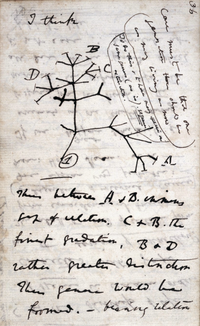
Photo from wikipedia
Abstract How microbes adapt to a novel environment is a central question in evolutionary biology. Although adaptive evolution must be fueled by beneficial mutations, whether higher mutation rates facilitate the… Click to show full abstract
Abstract How microbes adapt to a novel environment is a central question in evolutionary biology. Although adaptive evolution must be fueled by beneficial mutations, whether higher mutation rates facilitate the rate of adaptive evolution remains unclear. To address this question, we cultured Escherichia coli hypermutating populations, in which a defective methyl-directed mismatch repair pathway causes a 140-fold increase in single-nucleotide mutation rates. In parallel with wild-type E. coli, populations were cultured in tubes containing Luria-Bertani broth, a complex medium known to promote the evolution of subpopulation structure. After 900 days of evolution, in three transfer schemes with different population-size bottlenecks, hypermutators always exhibited similar levels of improved fitness as controls. Fluctuation tests revealed that the mutation rates of hypermutator lines converged evolutionarily on those of wild-type populations, which may have contributed to the absence of fitness differences. Further genome-sequence analysis revealed that, although hypermutator populations have higher rates of genomic evolution, this largely reflects strong genetic linkage. Despite these linkage effects, the evolved population exhibits parallelism in fixed mutations, including those potentially related to biofilm formation, transcription regulation, and mutation-rate evolution. Together, these results are generally inconsistent with a hypothesized positive relationship between the mutation rate and the adaptive speed of evolution, and provide insight into how clonal adaptation occurs in novel environments.
Journal Title: Genome Biology and Evolution
Year Published: 2021
Link to full text (if available)
Share on Social Media: Sign Up to like & get
recommendations!